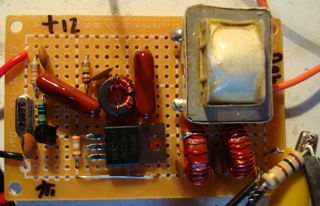Encouraged by the success of the beacon transmitter, I've built another version that is amplitude modulated using a 600 ohm telephone transformer.The transmitter is just 2 transistors, (not counting the mic pre-amp and audio power amplifier), here's how it looks:

Whistling into the microphone looks like this on the cro:

Next step is to box all this up and make it a bit easier to switch from receive to transmit. (Currently I have to clip a clip lead on to power it and switch a co-ax switch).The circuit is closely based on the beacon by Alan VK2ZAY. My construction is huge compared to his.

For the audio amplifier to drive this I used a Jaycar "Short Circuits 3" #13 High Power 12V amp which seems to do the trick quite nicely.
One "inefficient" by extremely simple way to get full modulation depth is to replace the transformer with an NPN emitter follower. Bias its base such that its emitter sits about mid-rail (ie carrier output 1/4 of PEP), then AC couple your AF signal to the base so the emitter tracks it about 600 mV less. It can then swing right up to the rail minus the saturation voltage and right down to cut-off, giving you pretty linear modulation up to essentially 100%. Trapezoid tests will let you set the bias pot for optimal modulation but "mid rail" will be quite close to optimal.
Of course the transistor drops 1/2 the rail voltage across it at the quiescent collector current, so it simply burns up that power as heat. The device must be suitably rated for the power dissipation and collector current, but a BD139 with a small heatsink is probably suitable for an initial try.
Such a class-A modulator is frowned upon as inefficient, but it is extremely simple, easy to build and easy to drive. It skips all the high-power AF amplifier stages and the heavy modulation transformer.The base input impedance of the modulation transistor will be a little low - about 5K I'd estimate from the load and beta. You'll need to provide a full swing into that load as the emitter follower has no voltage gain, but that is easy to achieve with an op-amp (or even just an common emitter amp if you don't mind not quite making it to 100%).
No comments:
Post a Comment